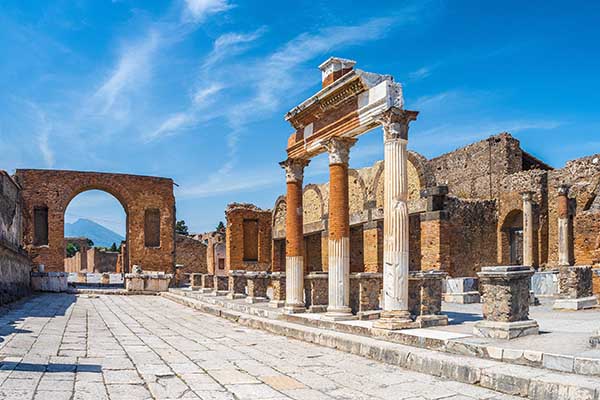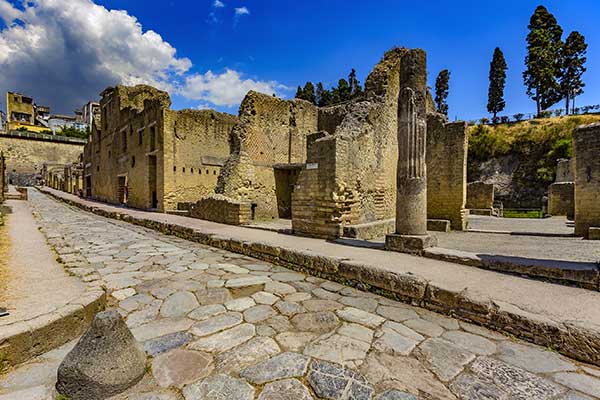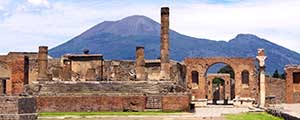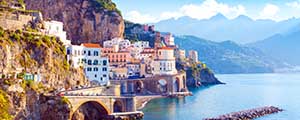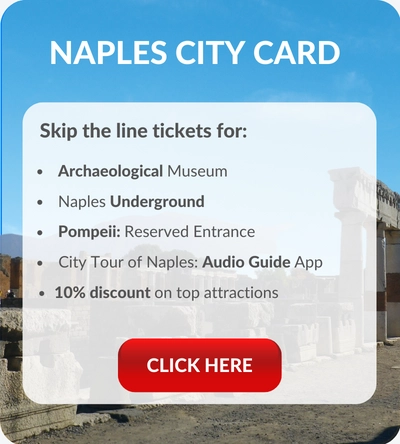
Naples Excursions & Amalfi Coast Tours
8x Excursions, day trips and Amalfi Coast tours from Naples Italy

All info about tours, excursions and day trips from Naples (Napoli). Tips for day trips and the best Amalfi Coast tours from Naples Italy can be found here:
Day trips from Naples? - 8 Tips for Naples tours
Would you like to escape the busy city and discover what else the Naples area and the Amalfi Coast has to offer? Then you will have no trouble finding a number of fun day trips. Of course, close to Naples Italy you will find top attractions such as the Mount Vesuvius volcano and the excavations of the cities Pompeii and Herculaneum. If you would like to discover more of the beautiful region, consider the following eight day trips and excursions from Naples:
1. Amalfi Coast tours from Naples
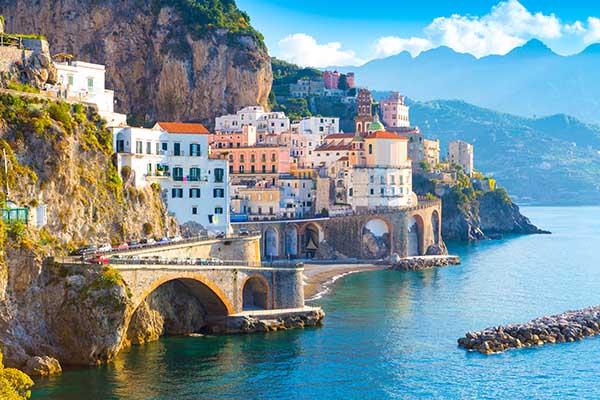 Atrani, one of the beautiful places on the Amalfi Coast
Atrani, one of the beautiful places on the Amalfi Coast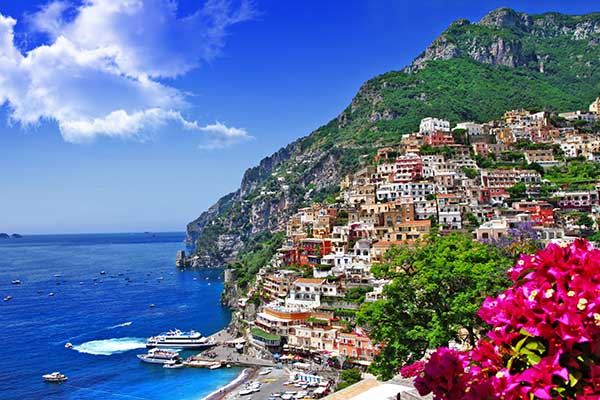 Visit Positano during an Amalfi Coast tour
Visit Positano during an Amalfi Coast tourThe Amalfi Coast can be seen as one of the most beautiful coastlines in Europe. It even became a UNESCO World Heritage Site in 1996. You will find cozy and charming centuries-old villages that stand almost perpendicular to the cliffs. Each village has its own character, but they all have one thing in common: a view of the Tyrrhenian Sea. ✅ Tip: Last time I booked this amazing Amalfi Coast day trip from Naples which included the visit of Sorrento, Amalfi and Positano. These are the recommended places during an Amalfi Coast day trip:
- Positano: This town is one of the most popular towns along the Amalfi Coast and also the first village on the coastline. You can get lost in Positano through the narrow alleys with colorful facades. Once you reach the top you have a beautiful view of the sea. You can cool off from the long climb to the top on the fine sandy beach. In addition to day trips, Positano is very popular for young people for the nightlife.
- Sorrento: Sorrento is not officially part of the Amalfi Coast, but most tourists start at this town during an Amalfi Coast tour. If you are driving the Amalfi Coast from Naples, you will probably stop at Sorrento. The place is known as a seaside resort, but also for its lemon groves. At most shops in the village you can get fresh lemon juice.
- Salerno: In the south you will find Salerno, which is an important trade center with a fast connection to Rome. Food is plentiful and you have several nice restaurants. In addition, Salerno has a vibrant nightlife.
- Amalfi: Amalfi is the largest town on the Amalfi coastline and the most popular resort for tourists. In addition, Amalfi is the base for tourists who want to explore the Amalfi Coastline. Both Sorrento to the west and Salerno to the south are a 40 minutes' drive from here.
2. Naples to Capri day trip
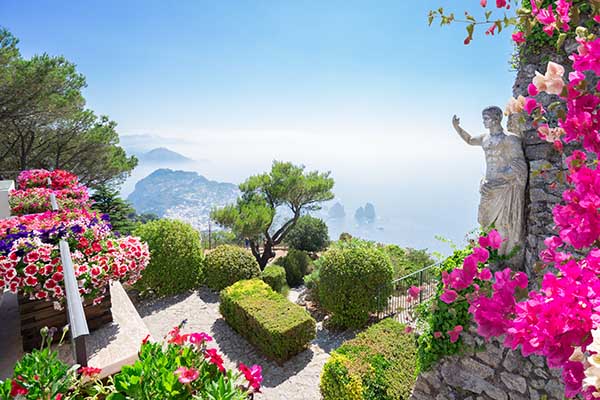 Capri, an ideal island to visit with a day trip from Naples
Capri, an ideal island to visit with a day trip from Naples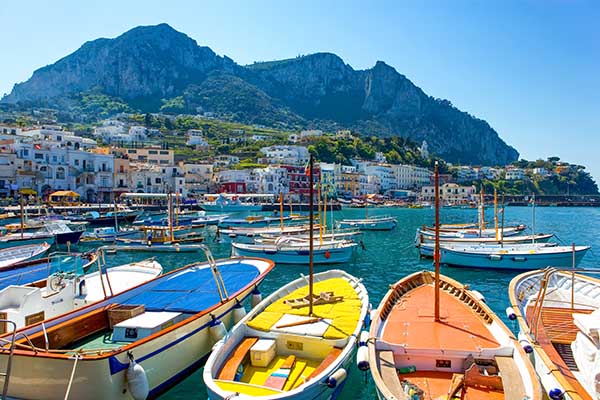 Naples day trips to the picturesque island of Capri
Naples day trips to the picturesque island of CapriCapri Island has long been very popular among tourists for its beauty and beautiful views. It is very green, has impressive steep cliffs and the Blue Grotto is a popular sight. In addition, the streets of the villages on Capri are decorated with colorful flowers and interesting street signs. Capri is surrounded by azure blue water where many sailing yachts sail. You definitely don't have to get bored on Capri, but how do you get to the island? This always goes by ferry from the port of Naples (a single journey takes 50 minutes and tickets can be booked at this website; a return costs around 40 - 50 euros). It is also possible to book an organized day trip from 74 euros (info & bookings) to bring you to the island from Naples or Sorrento. Then you will sail to Capri in the morning, see the highlights and have time to, for example, go for a swim or explore the island. Most relaxed: book this fully organized day trip from Naples.
1. Book Ferry Tickets 2. Book Capri Day Trip
3. The island of Ischia
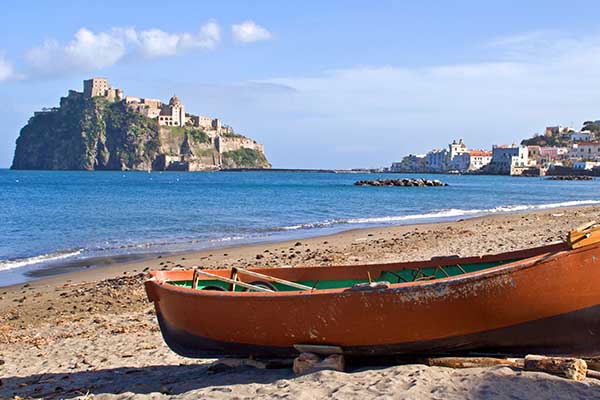 Visit the Island of Ischia in the Bay of Naples
Visit the Island of Ischia in the Bay of Naples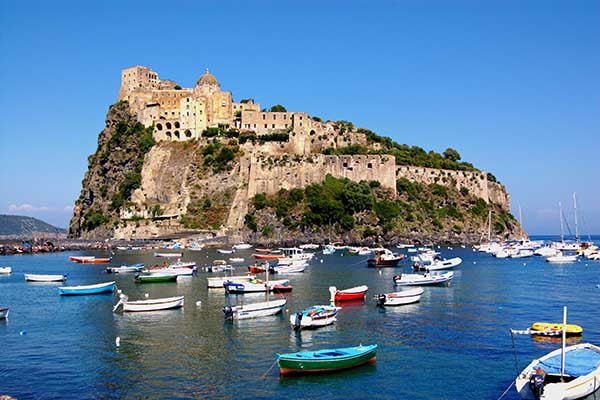 Castello Aragonese on the island of Ischia
Castello Aragonese on the island of IschiaIschia is a volcanic island and has only 60,000 inhabitants. Not very big, but there is plenty to do. The island is known for mud baths and thermal springs. Very suitable for people with rheumatism or bone disease. Ischia has several villages, of which Ischia town is the most popular. You will find the cosiness at Riva Destra with countless nice bars and restaurants. Torre di Guevara is a must-see that served as a defense for the island. It was built in 1433. Off the coast of Ischia lies Castello Aragonese, a peninsula that you should not miss during your visit to Ischia. The medieval castle is connected to the mainland by a dike. Castello Aragonese itself is about 2500 years old. In 1912 it came into the hands of a private owner and has been restored to its former glory partly thanks to the proceeds of the entrance fees. You always visit Ischia by ferry (ferry info and tickets, the sailing time is one hour and a return ticket will cost around 40 euros). You can also book this organized day trip from Naples.
1. Book Ferry Tickets 2. Ischia Day Trip
4. Naples tours: Island of Procida
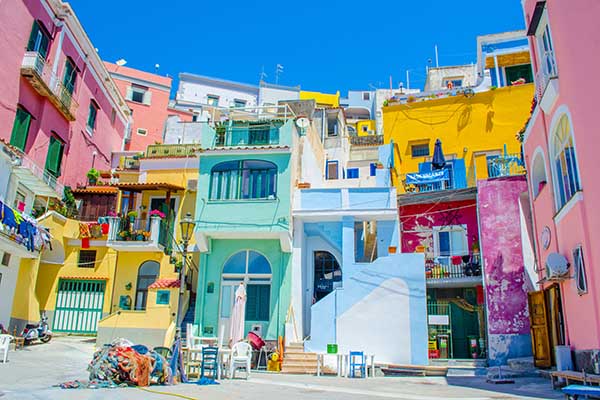 The old town on Procida is known for its colored facades
The old town on Procida is known for its colored facades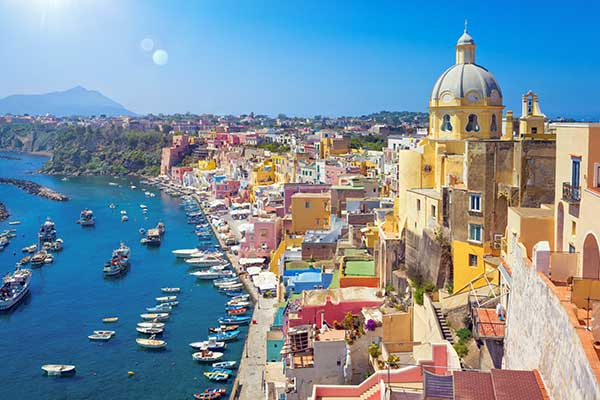 The island of Procida is easy to visit by ferry from Naples Italy
The island of Procida is easy to visit by ferry from Naples ItalyProcida, the smallest island of the Gulf of Naples, has been declared cultural capital in 2022. And that's not only because of the great monuments and rich history, but also beacause of the simple island life. You sail to this island from Naples or Pozzuoli (info ferry service, sailing time is 40 minutes and a return costs 30 - 40 euros. You can also book this organized day trip from Naples). Marina Grande is the port of arrival and you can walk to Marina Corricella in fifteen minutes. Stroll through the Marina Corricella known for its colorful houses and climb to the highest point for fantastic views of the island. What to do in Procida: At the end of the day, eat at one of the many restaurants or near the beach. Procida has a length of only 3 kilometers, so you can take your time to explore the island. The possibility is to do this on foot (it takes a maximum of 6000 steps from point A to B) or you can rent a scooter and enjoy all the beauty this island has to offer while driving (more info Procida day trips).
5. Day trip from Naples to Caserta
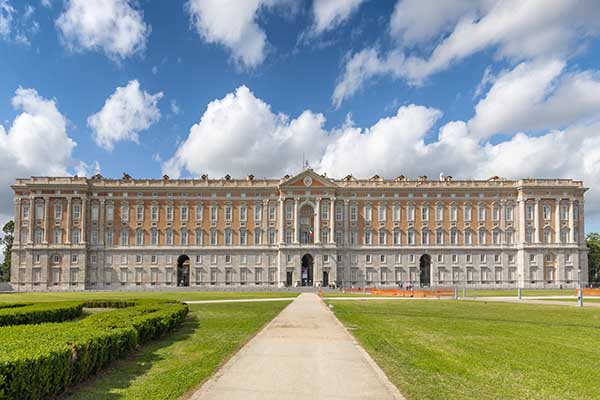 Day trip from Naples: the imposing Caserta palace
Day trip from Naples: the imposing Caserta palace One of the beautiful rooms in the Palace of Caserta
One of the beautiful rooms in the Palace of CasertaCaserta is a town 30 kilometers north of Naples in the Campania region. What Caserta makes famous is the Palace of Caserta. Its construction was commissioned by King Charles VII of Naples. The architecture has a Dutch touch, because the architect of the Palace of Caserta was Luigi Vanvitelli, son of Dutch painter Casper van Wittel. Luigi Vanvitelli moved to Rome in 1675. During the Second World War, the Palace was used as headquarters for the Allies.
6. Pausilypon (Posillipo)
 The Archaeological Area of Pausilypon
The Archaeological Area of Pausilypon A Roman amphitheater in Pausilypon
A Roman amphitheater in PausilyponThanks to the restoration work of the Archaeological Sovrintendenza of Naples and Caserta and the contribution of the Municipality of Naples, the first part of the enormous archaeological site of Pausilypon has been opened to the public. You will find here at 16 kilometers from Naples, the Grotta di Seiano, a tunnel made by people of 770 meters long. After the tunnel you arrive at a villa. The Roman knight Vedius Pollione of Ottaviano Agusto gave the villa the name Pausilypon (translated: 'place that takes away all cares'). The reason for this name is because the knight found it enchanting and an area full of beauty. You also have remarkable archaeological remains in Pausilypon. You have ancient theaters such as that of Odeion, the Temple of Sacrarium and the Nymphaeum. Via this website you can book an Electric Bike Tour from Naples to the Pausilypon Archaeological Park.
7. Paestum day trip
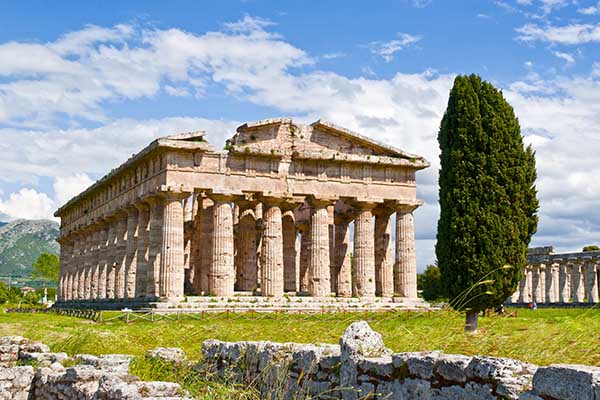 The Archaeological Area of Paestum
The Archaeological Area of Paestum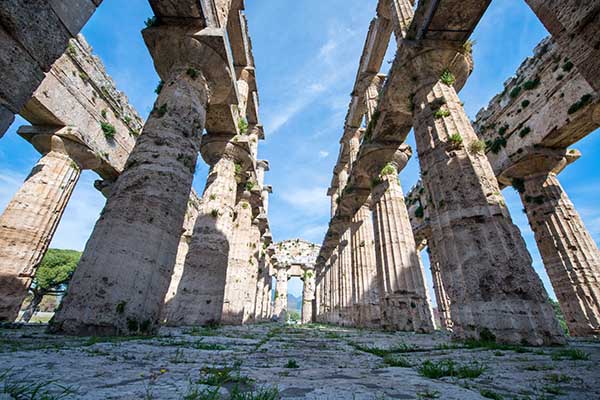 Visit one of the ancient temples in Paestum
Visit one of the ancient temples in PaestumThe construction of these temples of Paestum started about 2500 years ago by the Greeks. It was given the name Poseidonia and is located 93 kilometers south of Naples. Later when the Romans took over the city, it was given the name Paestum. Today, all the temples and excavations are located on a site of green lawns, rose bushes and cypress trees. Very interesting for tourists, while the locals mainly pay attention to the nearby stalls. Excavations took place from the 1930s onward and yielded some wonderful artifacts and paintings on display in the small archaeological museum. Paestum used to be a thriving trading city where today you can more or less experience this history in real life through the excavations. Not as famous as Pompeii and Herculaneum, but just as interesting (more info and tickets).
8. Parco di Gaiola
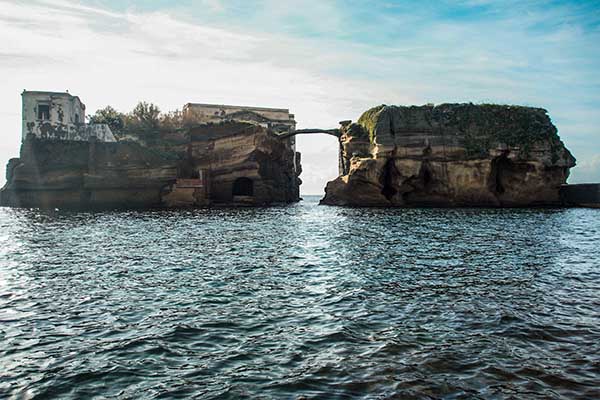 Near Naples Italy is the Parco di Gaiola
Near Naples Italy is the Parco di Gaiola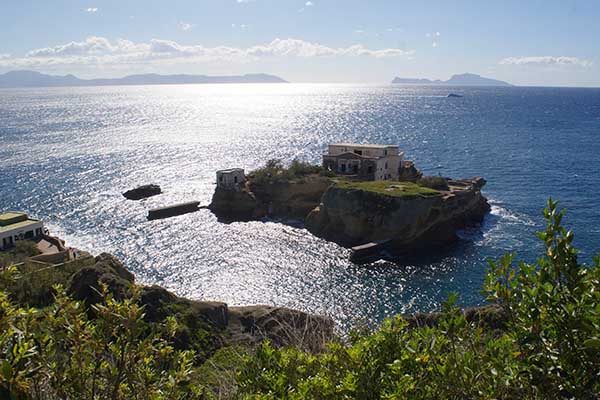 Gaiola, visiting the marine reserve
Gaiola, visiting the marine reserveParco di Gaiola is a marine protected area since 2002, and takes its name from two islets off the coast of Posillipo in the northwestern part of the Gulf of Naples (16 kilometers from the center of Naples). The underwater park is managed by the Centro Studi Interdisciplinari Gaiola and is unique thanks to the combination of volcanic, biological, historical and archaeological aspects. This in an environment of one of the most beautiful coastlines of the Gulf. Today, Parco di Gaiola is an important place for scientific research, training and environmental education with the aim of rediscovering and revitalizing the natural and cultural heritage of the Gulf of Naples.

